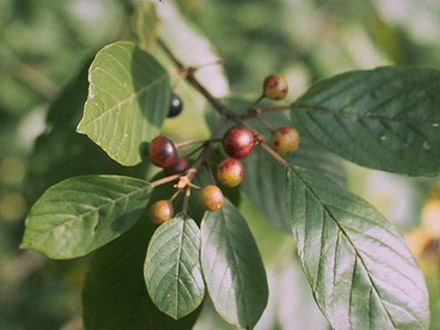Botanical name
Alder buckthorn - Frangula alnus Mill. (Syn. Rhamnus frangula L.)
Cascara buckthorn - Frangula purshiana (DC.) A.Gray ex J.G. Cooper (Syn. Rhamnus purshiana DC.)
Family
Rhamnaceae
Common name
Alder buckthorn, Glossy buckthorn, Breaking buckthorn
Cascara buckthorn, American buckthorn, Cascara sagrada, Chittam Bark
Information about the plant
The alder buckthorn is native to Europe, western Asia, Anatolia, and the Caucasus, and it grows wild in North America. It typically grows as a strong shrub or small tree (1-3 m high, sometimes higher) from the plain to the lower mountain area, in light deciduous and coniferous forests, preferably at the forest edges, as well as in bushes and hedges, along watercourses, and on moors. At 6 to 10m high, the cascara buckthorn is a strong tree that is native to the Pacific coast of North America, from southern Canada to central California, where it is also cultivated.
The genus name Frangula comes from the Latin "frangere" (= to break) and refers to the brittle nature of the wood of the shrub or tree. The epithet alnus (= alder) clearly draws a similarity of the leaves with those of the alder. The German name “Faulbaum” (foul tree) was given due to the foul smell of the fresh bark.
The alder buckthorn is characterized by horizontally projecting branches. Its bark is green when young, later it turns grey-brown and is clearly characterized by distinct, diagonally arranged, grey-white lenticels. Even the bark of the cascara buckthorn has these clear lenticels. The leaves of both species are similar, they are stiff, elliptic to obovate, and entire. The flowers of alder buckthorn are inconspicuous and greenish-white, while the American buckthorn flowers are white. They grow in axillary cymes with 2 to 10 flowers each. After fertilization, they mature into berry-like drupes that change color from green to red and finally black as they ripen. The flowering period is from May to June.
Medicinally used parts of plants (herbal drug)
The dried whole or ground bark of the trunks and branches of both species are used. The bark of the alder buckthorn (alder bark) comes from the wild or cultivations in riparian forests in Eastern Europe, mainly in Poland. After harvest in early summer, the fresh bark must either be stored for one year or dried in a hot air stream at 80 – 100 °C (see ingredients). The bark of the cascara buckthorn (cascara bark) comes from cultivations in the U.S. states of Washington and Oregon, and from western Canada.
Constituents of the herbal drug
Buckthorn bark (from the alder buckthorn) contains anthranoids (hydroxyanthracene derivatives, "anthraquinones") and mainly glucofrangulin and frangulin. They are formed during storage or drying in a hot air stream from the oxidation of the corresponding anthraquinone glycosides. Cascara bark (from the cascara buckthorn) also contains anthranoids, mainly cascaroside, along with aloin.
Quality of the drug
The quality of the following drugs or drug preparations is specified in the European Pharmacopoeia (Ph. Eur):
- Buckthorn bark (Frangulae cortex)
- Standardized buckthorn bark dried extract (Frangulae corticis extractum siccum normatum)
- Cascara bark (Rhamni purshianae cortex)
- Standardized cascara dried extract (Rhamni purshianae extractum siccum normatum)
Medical applications
Recognised medical use
The HMPC has accepted the internal use of buckthorn bark and cascara bark (cascara buckthorn bark) as “well-established use” for the short-term treatment of occasional constipation.
ESCOP: Buckthorn and cascara bark: for short-term treatment of occasional constipation.
Traditional use
Not applicable
Herbal drug preparations in finished dosage forms
- Chopped or coarsely pulverized buckthorn bark or cascara bark as tea.
- Buckthorn bark dry extracts standardized on anthranoids (glucofrangulin A) in solid dosage forms.
- Cascara dry extracts standardized on anthranoids (cascarosides) in solid dosage forms
Dosage
Finished medicinal product: see patient information leaflet.
Tea: 20 to 30mg of anthranoids per day is sufficient for a laxative effect. This is achieved with an infusion of 0.5g of buckthorn bark or cascara bark. The tea should be taken in the evening before bedtime. It is useful to combine it with other drugs, such as senna leaves (which have a laxative effect too) or cumin (for flatulence).
Preparation of a tea
Pour 150 ml of boiling water over 2 g of finely chopped buckthorn bark or cascara bark and strain after 10 to 15 minutes.
Notes
Buckthorn bark or cascara back must not be taken for over 1 to 2 weeks (gut-irritating laxative); long-term use increases constipation.
Buckthorn bark or cascara bark should not be taken for intestinal obstruction, appendicitis, inflammatory bowel disease (e.g. Crohn's disease, ulcerative colitis), abdominal pain of unknown origin, and severe dehydration symptoms. A slight discoloration of urine can occur while taking buckthorn bark or cascara bark.
Although there have been no reports of adverse or harmful effects from buckthorn bark or cascara bark in pregnant women and the fetus, due to the potential genotoxic properties of various anthranoids, it is advised to avoid taking buckthorn bark or cascara bark during pregnancy. The transfer of anthranoids into breast milk cannot be excluded, so the use of buckthorn bark or cascara bark during lactation is not recommended.
Side effects
Rarely cramp-like gastrointestinal complaints (reduce dosage!). The prolonged ingestion of buckthorn bark or cascara bark (laxative abuse) can lead to water/electrolyte metabolism problems, especially potassium loss. Blood and protein (hematuria, proteinuria) may appear in the urine. Chronic use leads to (reversible) pigment deposition in the intestinal mucosa.
Interactions
The chronic use of buckthorn bark or cascara bark (laxative abuse) can increase the effect of digitalis drugs (drugs with cardiac glycosides) due to potassium deficiency; the effect of antiarrhythmic drugs may also be affected. The concomitant use of thiazide diuretics, adrenal corticosteroids, and licorice root can further increase potassium loss.
References
Herbal drug monographs
HMPC (2019, 2020, 2022), ESCOP (2016, 2017), WHO Vol. 2
Further literature
Commentary on the European Pharmacopoeia (Buckthorn bark, No. 0025;
Buckthorn bark dry extract, No. 1214; cascara bark, No. 0105; cascara dry extract, No. 1844)


